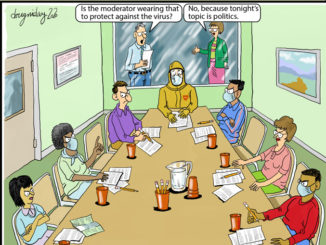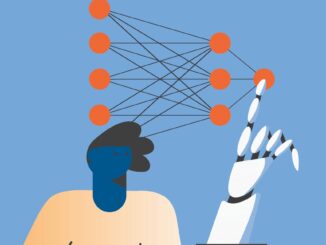 by David M. Schneer, PhD, CEO, Merrill Research and The Merrill Institute for Nonverbal Intelligence, Pleasanton, California, dschneer@merrillresearch.com
by David M. Schneer, PhD, CEO, Merrill Research and The Merrill Institute for Nonverbal Intelligence, Pleasanton, California, dschneer@merrillresearch.com
Communication contradictions: whether we realize it or not, we’ve all experienced them in some form or another. What do I mean? A customer expresses delirious interest in your proposal, but you never hear from them again. A job applicant confidently expresses their ability to fulfill a role, but two weeks into the job it’s clear they are unqualified, perhaps even toxic. A research participant has a positive verbal reaction to a new product concept, but their body language is not quite so convincing.
What Interview Were You Watching?
Not long ago, I interviewed a respondent to whom I showed a rough concept for a new product. As soon as I presented the concept, I noticed her body language was screaming that the concept did not resonate. There were several tells:
- Her arms were folded. While this is often a misunderstood body language position, in this case her arms were folded and stiff, and her fingers were pressing into her biceps, indicating stress.
- She was leaning back. Instinctively, we lean away from things we dislike and lean into things that we prefer.
- Her feet were pointing toward the door. The feet are the most honest part of the body, as they are always pointed where the body wants to go (Navarro 2008, 76). This is why we recommend focus group facilities (or negotiators) use glass tables so the lower extremities can be viewed. We also recommend swivel chairs to help accentuate body movement.
- One corner of her mouth quickly moved up, ever so slightly. This is clearly a sign of contempt, which can either indicate dislike or a feeling of superiority. In this case, an element of the concept rubbed her the wrong way.
- A wayward index finger began to tap to an unknown beat. Our digits have a language all their own. This was a clear indication that she was frustrated and ready to move on.
- She began to pick lint on her blazer, but there was no lint. This is a form of contempt, where she was essentially saying that she would rather pick imaginary lint off her jacket than tell me she disliked the concept.
“So,” I asked her, “tell me, what do you think?” “Oh, I like it,” she replied. “I’d buy it. Certainly.”
But that’s not what her body said. The unspoken signals I picked up suggested her reaction was not quite as rosy as her verbal feedback suggested. Eventually, I was able to determine what it was that bothered her about the concept, and it turned out to be valuable feedback.
After thanking her for her opinions, I hustled back to the observation room where the clients were huddled in the dark with glowing laptop screens. “She loved it!” one client exclaimed, high-fiving the other. “Killed it!” yelled the other.
I looked at them the way a dog sometimes does when it is trying to understand what its master just said: head cocked, one ear up, and one ear down. I thought to myself, “What interview were you watching?” That was when I advised my client to watch what participants do and not only listen to what they say. The concept just did not resonate with this respondent, and there were good reasons for that.
Lying: Ubiquitous but Not Always Sinister
Why would a person say one thing when their body language suggests something else? It is estimated that we hear as many as several hundred lies per day. Paul Eckman writes in his seminal book on lying, Telling Lies: Clues to Deceit in the Marketplace, Politics, and Marriage (Revised Edition), “Lies occur between friends (even your best friend won’t tell you), teacher and student, doctor and patient, husband and wife, witness and jury, lawyer and client, salesperson and customer.”
Let’s get this straight. There is no Pinocchio effect! (Navarro 2008, 230). The foremost global experts on lying all agree that there is no single sign that someone is fibbing (cf. DePaulo, Eckman, Ford, Frank, Freisen, Hartwig, Hwang, Levine, Matsumoto, Navarro, Skinner). Anyone who tells you otherwise is likely lying, and because liars lie about lying (John 8:44 NASB), it’s hard to know what to believe.

Moreover, the major worldviews—Islam, Judaism, Eastern Orthodox Christianity, Western Christianity—all denounce lying, albeit the Jewish tradition has exceptions for keeping the peace, protection against theft and harm, or for the sake of decency and/or humility (Friedman, Weisel 2003, 8).
Lying is not only an abomination and hard to detect, but it is ubiquitous, too (Navarro 2008, 208).
But how does lying really work? A closer look yields that lying is used for social survival (Navarro 2008, 208), and it’s used quite often. “She’s not home” (sure she is, she’s sitting right next to you). “I already donated” (no, you didn’t). “I’m not available” (you could go, but you don’t really want to). “I love it” (it’s the same tie you gifted me last year). That’s right, to avoid rocking the social boat unnecessarily, we lie.
But it gets worse. Not only are lies shunned, omnipresent, and elusive, numerous studies prove definitively that we humans are very poor lie detectors. Enter Timothy B. Levine’s Duped and the Truth Default Theory (TDT). We humans are “hardwired” for the benefit of the doubt (Levine, 2020, 14). Moreover, the TDT posits that most of the time most people tell the truth unless there is some detrimental consequence to being honest. Then people will lie. (Levine 2020, 246–247). Furthermore, most lies are not caught in real time (Levine 2020, 244).
According to Levine, truth engenders trust, and trust greases the wheels of social harmony. Thus, we lean toward belief for the sake of social cohesion. But what about that swirl of deception around us?
The TDT accounts for that, stating that the most destructive lies are told by a few prolific liars with catastrophic consequences (Levine 2020, 247). Think Bernie Madoff—the convicted Ponzi-scheme mastermind. His lies were not the “I-gave-at-the-office” type. They were sociopathic lies, devastating to those who believed them.
So, you think to yourself, okay . . . lying is shunned, hard to catch in real time, exists everywhere, and woven into the social fabric. Why bother?
Rather, one should focus on whether someone is comfortable or uncomfortable with what you are saying or what is coming out of their own mouth. Why? The same behaviors and gestures that make us look guilty are also the ones we exhibit when we are uncomfortable.
Want the Truth? Just BLINK
Here’s another research study where we employed a technique to help foster emotions. The technique I used was called BLINK: Body Language Intuition Numinology Know-How.
We emote faster than we think, which is exactly why the BLINK technique is so powerful. The basic premise of this technique is that instead of asking someone a question and waiting for their reply, you posit a supposition and watch the reaction on their face. That is, did they show signs of disgust, contempt, happiness, fear, sadness, anger, or surprise—or no emotion at all?
This technique takes advantage of the fact that we think slower than we emote. Our emotions are controlled by the limbic system—the part of the brain typically referred to as the “frog brain” or “reptilian brain.” Ask a person a question, and wait for them to formulate an answer. Use the BLINK technique, and watch the answer flash across their face without them even knowing it.
Using the BLINK Technique in Real-Life Settings
At the Merrill Institute, I used the BLINK technique in a qualitative channel study among Value Added Resellers (VARs), and the technique yielded jaw-dropping results. Back to that in a minute. First, let’s understand the target audience in this study. These VARs resold computer software, hardware, and networking products to small- and medium-sized companies, providing value beyond order fulfillment.
I talked with VARs in New York City during a series of hour-long in-person interviews. The objective of the study was to understand the needs of VARs selling their devices. What kind of support would they require? Better pricing and margins? Lead generation support? Market development funds? What would be the ideal channel plan? After asking a variety of questions regarding channel needs, we turned our attention to the major brands in the space.
“So,” I asked one of the VARs, “would it matter to you who the manufacturer is behind this channel plan?”
“Yes,” he replied, and before he could say anything else, I interjected the following presupposition—“Suppose I told you that the manufacturer behind this plan is Brand X.” In an instant the VAR flashed a half smile of contempt, a quick sign of fear, and then a sure sign of disgust, but then he said, “Brand X would be fine.” I could sense something was amiss.
“You know,” I said to him, “I’m sensing that there’s more to the story about Brand X.”
He looked at me and said, “Brand X is fine from the perspective of customer awareness. Everyone knows Brand X, but I’ll never do business with them again after they went around my back directly to my clients.”
We later learned that this VAR had registered a sizeable deal (over 50 devices) with Brand X—only to find out later that Brand X tried to cut him out of the deal by going directly to VAR’s customer. The lesson? Deal registration and no channel conflict are sacred! We might have missed that had we not employed the BLINK technique.
This is just one of the many instances where the BLINK technique can be used. Another example: an HR executive could quickly assess whether a job candidate is less than forthcoming about their previous work experiences just by looking at their reactions.
Experienced and new moderators—and client observers—will often miss the subtle and sometimes not-so-subtle signs about what a person is really saying, paying too much attention to the spoken word and not enough to nonverbal cues. We founded the Merrill Institute for Body Language Training for this reason—so everyone involved in qualitative research can become a body language expert.
References:
- Ekman, Paul. Telling lies: Clues to deceit in the marketplace, politics, and marriage. New York: W. W. Norton & Co, 2009
- John 8:44 NASB: “You are of your father the devil, and you want to do the desires of your father. He was a murderer from the beginning, and does not stand in the truth, because there is no truth in him. Whenever he speaks a lie, he speaks from his own nature; for he is a liar, and the father of lies.”
- Friedman, Weisel, Jewish Law. “Should Moral Individuals Ever Lie? Insights from Jewish Law,” 2003 (p 8).
- Hartwig, Maria. “Telling Lies: Fact, Fiction, and Nonsense, by Maria Hartwig: Should you believe Paul Ekman, world’s most famous deception researcher?”, Psychology Today, (2014): 15
- Navarro, Joe, and Marvin Karlins. Essay. In What Every BODY Is Saying: an Ex-FBI Agent’s Guide to Speed-Reading People. New York, NY: Harper Collins, 2015
- Timothy R. Levine. The University of Alabama Press, Tuscaloosa, Alabama, 2020
- Matsumoto, David, PhD, Hyi Sung Hwang, PhD, San Francisco State University and Humintell, LLC, Lisa Skinner, JD, SSA, Federal Bureau of Investigation, Mark G. Frank, PhD, “Evaluating Truthfulness and Detecting Deception and New Tools to Aid Investigators,” University at Buffalo, State University of New York. In press, Page 2, U.S. Department of Justice, Federal Bureau of Investigation, FBI Law Enforcement Bulletin




